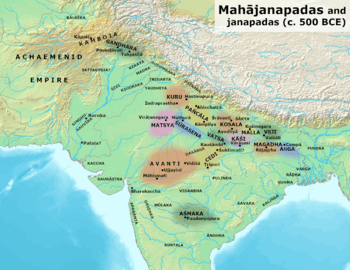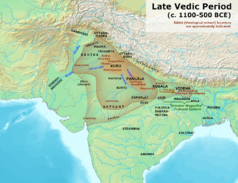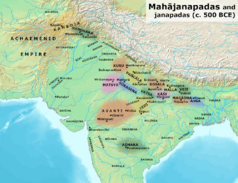Kāśī (kingdom) facts for kids
Quick facts for kids
Kingdom of Kāśī
|
|||||||
|---|---|---|---|---|---|---|---|
| c. 1000 BCE–c. 600 BCE | |||||||

The Kāśī kingdom and the other Mahajanapadas in the Post Vedic Era
|
|||||||
| Capital | Vārāṇasī | ||||||
| Common languages | Sanskrit Prakrit Pali |
||||||
| Religion | Historical Vedic religion Jainism |
||||||
| Government | Monarchy | ||||||
| Historical era | Iron Age India | ||||||
|
• Established
|
c. 1000 BCE | ||||||
|
• Conquered by Kaṃsa of Kosala
|
c. 600 BCE | ||||||
|
|||||||
| Today part of | India | ||||||
Kāśī (Pali: Kāsī) was an ancient kingdom in India. It existed during the Iron Age, a time when iron tools and weapons became common. The people of Kāśī were called the Kāsikas or Kāśikas.
Where Was Kāśī?
The Kāśī kingdom was quite large, covering an area of about 300 leagues. To the north, the Sarpikā or Syandikā river separated it from the Kosala kingdom. The Son river formed its southern and eastern borders. This river also separated Kāśī from the Magadha kingdom in the east.
The capital city of Kāśī was Vārāṇasī. This city had many other names, including Ketumatī, Surundhana, Sudassana, and Brahmavaddhana.
Kāśī's History
The Kāśikas were first mentioned in an ancient Indian text called the Paippalāda recension of the Atharvaveda.
The ruling family of Kāśī was likely part of the Bhārata clan. At one point, a king named Dhṛtarāṣṭra (or Dhataraṭṭha) ruled Kāśī. He was called a "Bharata prince" in an old text. This king was defeated by another Bharata king, Śatānīka Sātrājita. After this defeat, the Kāśikas stopped performing certain religious rituals for a while.
However, not all kings of Kāśī belonged to the same family. Ancient stories called the Jātakas often mention that ruling families in Kāśī would sometimes end. New kings from different families would then take over. Some kings of Kāśī even came from the Magadha or Videha regions. Many of these kings used the special name Brahmadatta. This was a title, not always a family name. For example, some Brahmadattas were from Magadha, while others were from Videha.
Kāśī was closely connected to the Kosala and Vaideha kingdoms. A wise man named Jala Jātūkarṇya served as a priest for all three kingdoms. This was during the time of the Kāśika king Ajātaśatru. King Ajātaśatru was known for his philosophical discussions, which are mentioned in ancient texts called the Upaniṣads.
Another king of Kāśī, named Bhadrasena Ajātaśatrava, was likely the son of Ajātaśatru. He is mentioned in the Śatapatha Brāhmaṇa.
According to some old stories, the famous heroes Daśaratha and Rāma were kings of Kāśī. However, other stories say they were kings of Kosala.
Two other important kings of Kāśī mentioned in ancient texts were Divodāsa and his descendant, Daivadāsi Pratardana.
Around 900 BCE, the king of Kāśī was Aśvasena. He was the father of Pārśvanātha, who became the 23rd Jain Tīrthaṅkara (a great spiritual teacher in Jainism).
Kāśī's Power and Decline
By the later Iron Age, Kāśī had become one of the strongest kingdoms in ancient South Asia. Many stories describe Vārāṇasī, the capital, as being superior to other cities. The rulers of Kāśī wanted to be the most powerful. They aimed to be the "King of All Kings" and the "Lord of all South Asia." Vārāṇasī was a very large city, much bigger than other important cities of that time.
Kāśī's kings often fought with their neighbors.
- One Kāśika king and his army fought against Kosala and captured its capital, Srāvastī.
- Another Kāśika king, Brahmadatta, is said to have taken over Kosala after executing its king.
- King Manoja of Kāśī is said to have conquered the kingdoms of Kosala, Aṅga, and Magadha.
- Some texts even claim Kāśī had influence over the kingdom of Aśmaka, far to the south.
However, other kingdoms also wanted to control Kāśī. At one point, seven kings tried to conquer Vārāṇasī. Stories tell of the Kosala king seizing Kāśī from King Mahāsīlava. Kings Vanka and Dabbasena of Kosala also managed to gain control over Kāśī at different times.
Kāśī was finally conquered for good by the kingdom of Kosala. This happened under Kosala's king Kaṃsa, shortly before the time of the Buddha. King Kaṃsa was even nicknamed "Barānasiggaho," which means "seizer of Vārāṇasī." By the time of Kosala's king Mahākosala, Kāśī was fully part of the Kosala kingdom.
Later, when Mahākosala's daughter married King Bimbisāra of Magadha, she received a village in Kāśī as a gift. This village provided a lot of money. The rest of Kāśī remained part of Kosala, ruled by Mahākosala's son Pasenadi.
After King Bimbisāra was killed by his own son, Ajātaśatru, King Pasenadi of Kosala took back the gifted village in Kāśī. This led to a war between Kosala and Magadha. The war ended when Pasenadi captured Ajātaśatru. Pasenadi then gave his daughter, Vajirā, to Ajātaśatru in marriage. He also gave the village in Kāśī back to her as a gift, and Ajātaśatru was restored to his throne.
Eventually, Kāśī became part of the powerful Magadha empire. This happened when Ajātaśatru defeated Pasenadi's son and took over Kosala.



